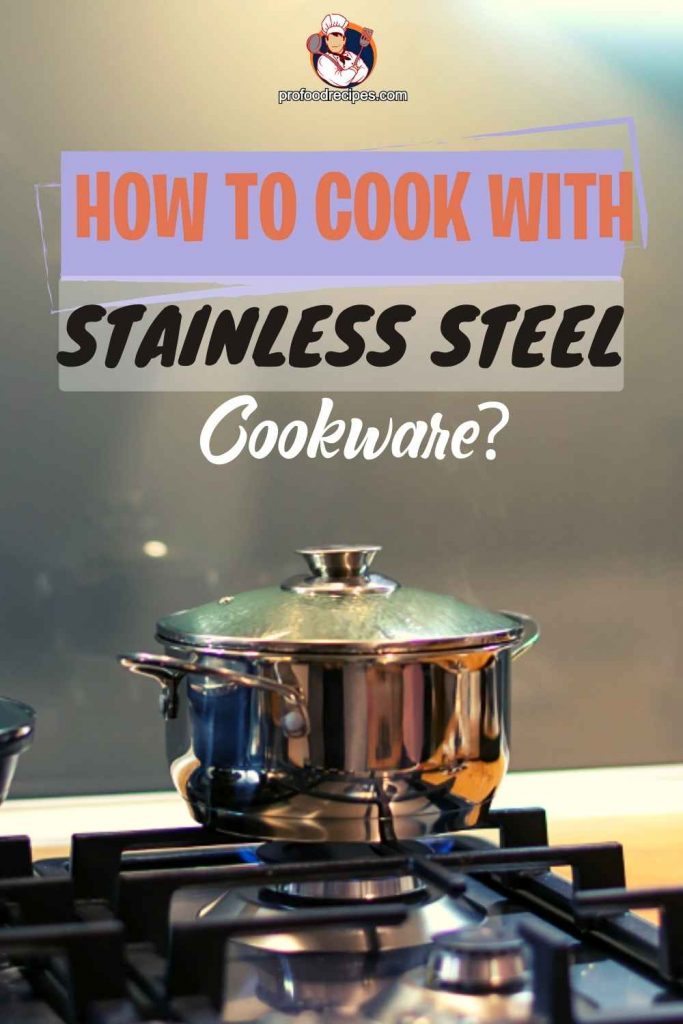Last Updated on November 4, 2022 by Amanda P. Brown
If your culinary experiments in stainless steel cookware fail to fulfill your desires, then you do not know a few iron rules with which this steel lady will become your best kitchen friend.
Why Cook With Stainless Steel Cookware?
Table of Contents
Most chefs and restaurants cook with stainless steel cookware. Stainless steel is an excellent choice for durable, non-toxic, long-lasting cookware that is ideal for baking, boiling, and sautéing.
Also, stainless steel pans are dishwasher-safe, durable, oven-friendly, and great for everyday use. Their metal surface is generally excellent for searing foods and browning steaks. Stainless steel pans are also suitable for salmon, gravy, simmering sauces, shallow-fried French fries, fritters, fish sticks, and poultry.
Moreover, it is perfect for little batch baking because it holds heat well and cooks the food evenly. Stainless steel is low maintenance compared to cast iron or other materials.
Again, a stainless steel pan can use for any type of cooking. Some materials react with acidic foods, including aluminum, copper, and cast iron. But stainless steel does not react with acidic foods. In addition, the stainless steel has no non-stick coating. Therefore, there is no danger of eating something chemical with your dinner.
How to Cook With Stainless Steel Cookware?
1. Doesn’t Like It Hot
Thanks to the multilayer steel used by most manufacturers, the walls and bottom of the dishes are heated evenly. Therefore the cooking process goes not in one direction but several at once.
Therefore, we do not need to use high temperatures. If the recipe recommends cooking at a medium-high temperature (usually position 6 or 7), set the temperature to position 4 or 5.
2. Be Sure to Preheat the Pan
If it is recommended to reduce the preheating time in dishes with non–stick coating, then stainless steel is on the contrary. The fact is that cold stainless steel has a porous structure. And it is the edges of these micropores that are not visible that cause food to burn.
When heated, the steel expands, and the pores close, forming a smooth surface. Adding a bit of oil to the pan is another fantastic option. But it is in the preheated one. Otherwise, it will simply flow into the pores and contribute to food burning.

3. How Long Does to Heat
Over time, you will fill the heat on your hand. But you can use a simple test with water. Heat the pan until the edge is hot, then spray water into it. You can begin cooking as soon as the water forms a ball that can be rolled around the pan.
However, this is a moment that you should not miss. One easy step takes you from perfectly comfortable heat to scorching hot. That’s why it’s essential to prepare every ingredient before this time.
4. How to Butter Up
As we already know, you need to add it to a preheated frying pan. Therefore, we proceed: reheat, remove from the stove, pour oil, distribute it over the surface, rotate the pan, or use a cooking brush. Return to the stove and start cooking after 3-5 seconds.
5. Hints From Meat
The meat itself will give you a signal when it’s time to turn it over. If you have properly heated the pan and added oil, then as soon as the meat stops sticking to the pan, this signals that it is already browned and it is time to turn it over.
After all, when such a desired crust is formed, no particles are left that get stuck in micropores, and your frying pan will easily give you your steak. Meat is not ready if you need to assist it with a spatula.
6. Leftovers Are Sweet
The brown leftovers that stick to the pan are a bonus that your frying pan gives you. It is an excellent base for sauces and gravies. For professionals, this is called de-glazing.
After removing the finished dish from the pan, drain the fat, add the liquid (it can be water, broth, or wine), return the pan to the stove, and bring it to a boil, scraping off the stuck remains from the surface.
Please do this by constantly stirring the liquid until it is about half cooked, then add the desired seasonings and spices and get a fragrant, rich sauce to your dish.
Read More: How to Care for Stainless Steel Cookware?
7. Keep Fit
Temperature changes easily deform stainless steel cookware, so never pour cold water into a hot pan that has just been used. Please don’t rush into washing it until it’s cooled down.
8. No “Hard” Contacts
Your steel friend does not tolerate metal washcloths and steel wool. For cleaning, it is best to use baking soda or special stainless steel cleaners.
9. Friendship With the Dishwasher
It is another big plus. Stainless steel cookware is not at all afraid of the dishwasher. Sometimes in a particular neighborhood (with plastic, for example), it can form spots easily. Wipe them down with a microfiber towel dampened with white vinegar to restore their shine.
10. Make Sure that Your Food is at Room Temperature
Typically, your pan and meal must be at the appropriate temperatures before cooking. Adding cold food to a hot pan can seriously lower the pan’s temperature and ultimately become anathema to cooking food sticking. However, a great way to make your food is to let it reach room temperature or at least near it before cooking. Also, take your food out of the fridge before you cook it. Moreover, the time it takes for food to reach room temperature depends on the food item. For example, a thick steak takes longer than some broccoli or a piece of salmon.
11. Be Patient With a Sear
If you are searing a chicken, steak, fish, or something else, the pan will notify you when the meat is done. A proper sear creates a barrier between the pan and the flesh, resulting in a nice brown color outside. Then make sure you don’t lift it forcefully if it seems stuck; it requires more time. You should poke once in each direction. However, shake the pan, ready to be flipped if the flesh moves at will.
12. Don’t Warp Them
Generally, stainless steel cookware tends to warp when exposed to extremes of temperature. So do not run your freshly used pans or pots under the faucet for quick cooling. So, before cleaning them, you need to give each time to cool off.
Tips for Using Stainless Steel Cookware for the First Time
When buying new stainless steel cookware and intending to use it for the first time, you should know how to use it properly. The list of guidelines for using stainless steel cookware for the first time is as follows:
- Start by rinsing it in the dishwasher, washing it by hand, or washing it with dish soap and vinegar (about a quarter cup) in warm water. It removes residual oils from the manufacturing process so that you are starting fresh.
- Heat it for a sufficient time and add cooking oil in large quantities.
- Allow your food to cook until it releases itself from the pan.
- Use the remaining brown, sticky liquid to create the most delicious pan sauce possible.
- Let the pan cool.
- Repeat the procedure as needed.
Why Do Chefs Use Stainless Steel Pans?
Generally, chefs, restaurants, or professional chefs use stainless steel cookware because it is virtually indestructible. This stainless steel construction and materials offer higher heat distribution. Also, if this stainless steel pan is used correctly, it can keep the food from sticking.
You May Also Like to Read:
